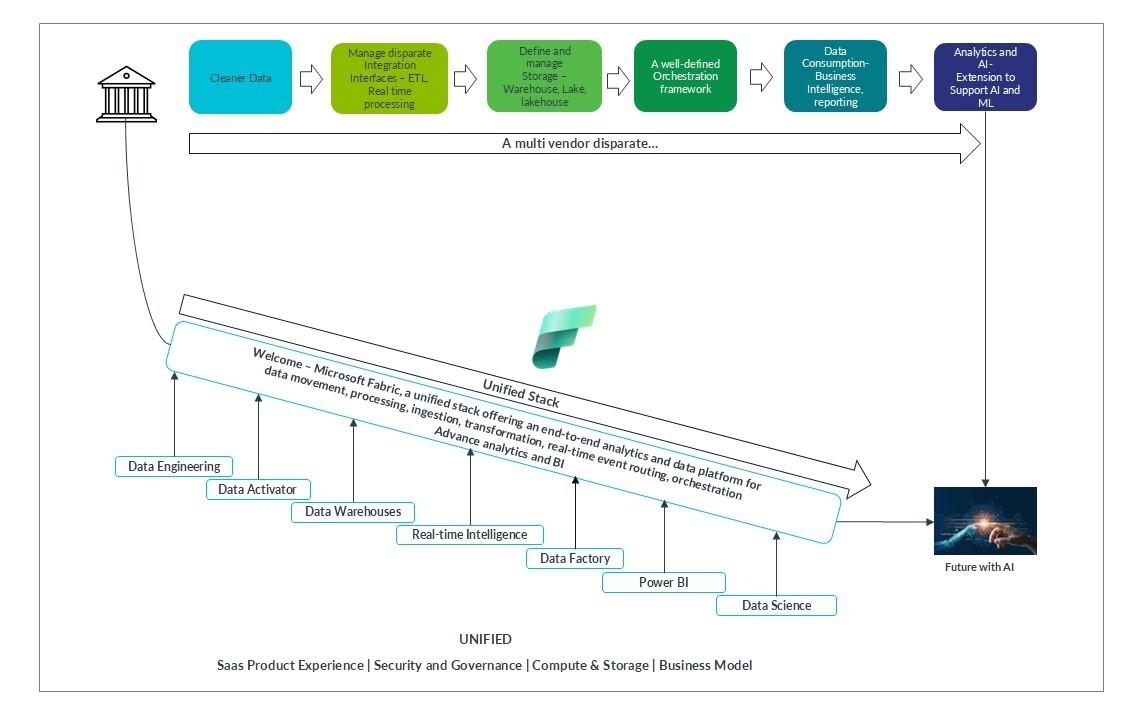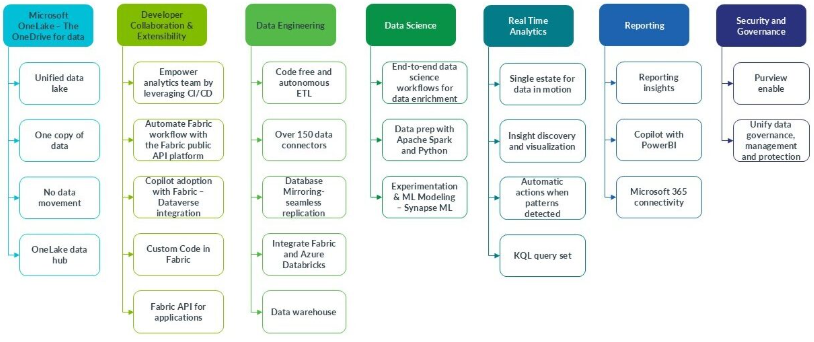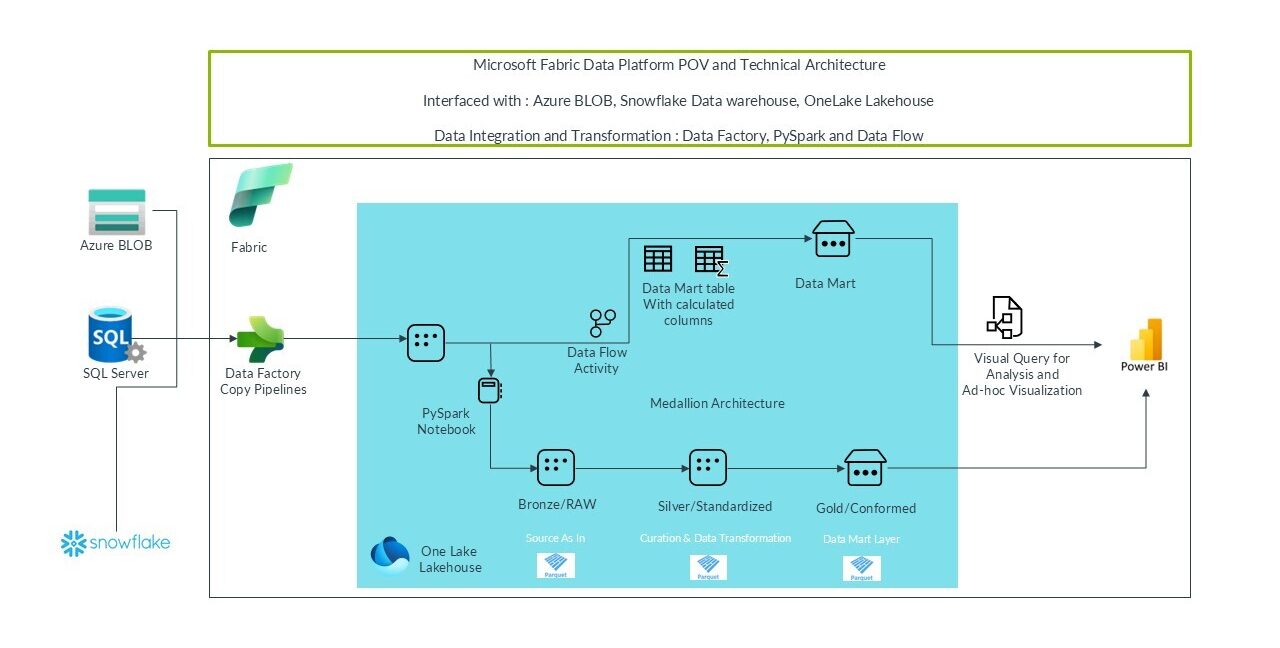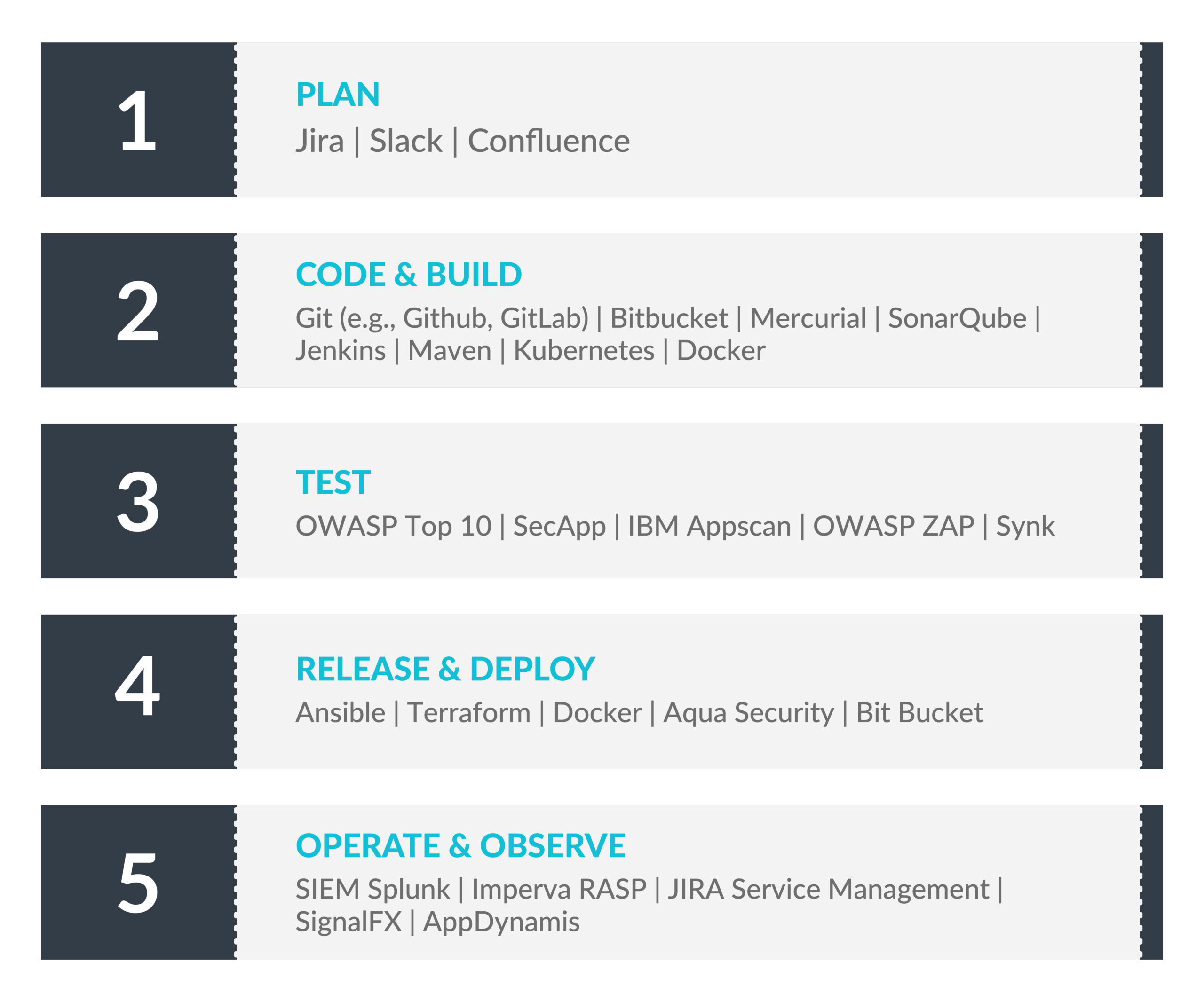Microsoft Fabric – A Unified View of the Modern Data Landscape
November 25th, 2024 WRITTEN BY Siddharth Mohanty - Sr. Manager, Data Management Tags: Clean Data, data management, Data Projects, De-duplication, Microsoft Fabric, modern data platform

Written By Siddharth Mohanty, Sr. Manager, Data Management
Stepping into The Future With AI
The future is AI.
From easy-to-use copilot experiences to custom generative AI solutions, every organization today is exploring how they can best utilize AI.
However, as businesses get ready for an AI-powered future, they will also require clean data to power AI. It takes a well-orchestrated data estate that can support everything from specialized AI initiatives to scalable AI solutions that span the whole organization to foster game-changing AI innovation. This is a challenging prospect for most organizations whose data environments have grown organically over time with specialized and fragmented solutions. A complex data estate leads to data sprawl and duplication, infrastructure inefficiencies, limited interoperability, and data exposure risks.
Data leaders who wish to help businesses streamline and advance their data estate must evaluate thousands of data and AI offerings, select the best services, figure out how to integrate them, and do all of this in a way that is flexible and scalable enough to change as the business grows.
Microsoft Fabric has eliminated the need for spending time integrating specialist solutions and managing complex data estate by introducing a unified stack of end-to-end analytics and data platforms.
Below is what we, at Fresh Gravity, envision the transition from a fragmented technology stack to a unified platform would look like with Microsoft Fabric.

Microsoft Fabric – Key Features
The Microsoft Fabric platform is the unified foundation of Fabric—an end-to-end, unified analytics platform that brings together all the data and analytics tools that organizations need. Secure and governed by default, Fabric provides a unified Software as a Service (SaaS) experience, a unified billing model, and a lake-centric, open, and AI-powered framework for your data analytics. Listed below are all capabilities that get implemented by MS Fabric.

Microsoft Fabric Capabilities
Microsoft Fabric Implementation Use Cases
With its unified architecture, Microsoft Fabric can implement all Data Management and Data Science use cases. Listed below are some key implementation use cases –

Select Use Cases
Fresh Gravity POV for a Data Platform Implementation
As part of expanding on the MS Fabric capabilities, at Fresh Gravity, we have recently designed and built an in-house mini-data platform for ingesting data files from various sources, landing the data to a landing zone on Fabric, processing and transforming the data using the Medallion Data Lakehouse architecture and finally serving the data for consumption via Power BI.
Key Features of our mini-data platform:
- Sets up workspaces in Power BI Fabric license
- Sets up OneLake Lakehouse
- Builds Data Factory copy pipelines to read data from Azure BLOB, Snowflake, and SQL Server and land the data to a transient landing zone on OneLake
- Uses Pyspark notebooks to read data from the landing zone to the bronze table on the OneLake Lakehouse
- Uses Pyspark to perform transformations, cleansing, and standardizations as needed to load the silver table. At Silver, the notebooks apply canonical data models, normalizations, SCD Type 1, SCD Type 2, etc
- Uses the Gold table as data mart tables with domain aggregates for reporting purposes
- Added flexibility allows a separate data flow built-in for ad hoc analysis of the raw files landing on OneLake lakehouse which can be further used via visual query for reporting in PowerBI
Below is the architecture diagram of the mini-data platform built on MS Fabric –

Architecture diagram of the mini-data platform built on MS Fabric
With newer Microsoft Fabric services becoming GA releases, Fresh Gravity is working proactively to stay ahead by building and deploying real-life data projects on MS Fabric. Stay tuned as we continue to share similar blogs and thought leadership content on various other aspects of Microsoft Fabric.
To learn more about our data project implementations, best practices, and regulatory-compliant solution designs using industry-standard tools and services, please write to us at info@freshgravity.com.
What is Dev [Sec]Ops and why is it important?
June 7th, 2023 WRITTEN BY Siddharth Mohanty - Sr. Manager, Data Management Tags: blog, data management, devsecops, Industry-agnostic

Written By Siddharth Mohanty, Sr. Manager, Data Management
Background of Dev vs. Ops – Entry of DevOps
Traditionally, the software development activities were categorized into two distinct phases- Development and Operations, carried out by 2 separate teams- Development and Operations/Deployment Team. It caused a sequential nature of ownership of activities, and inefficiency from conflicting siloed functional responsibilities of each team. That in turn led to poor-quality software, slow and delayed deployments, and long lead times to patch and fix vulnerabilities. As a result, the time to market/release cycles for each product spanned over months. In today’s data world, such a long development cycle is not sustainable.
To resolve this problem, a collaborative approach was needed which would bridge the gap between the development and operations teams to increase efficiency and speed, of software development and delivery. Thus, enabling organizations to serve their customers effectively and increase their competitive edge. To address that need eventually, the industry created DevOps!
A DevOps culture means developers get closer to the user by better understanding the user’s requirements. Operations teams get involved in the development process, operations, requirements, requirements, and customer needs. The objective is to deliver applications and services at a faster pace without compromising quality.
The DevOps lifecycle consists of eight phases representing the processes, capabilities, and tools needed for development (on the left side of the loop) and operations (on the right side of the loop). Throughout each phase, teams collaborate and communicate to maintain alignment, velocity, and quality.

Benefits of DevOps
Speed. Faster innovation and ability to adapt to evolving market conditions.
Rapid delivery. Accelerated product improvements and faster time to market.
Reliability. Quality application updates and infrastructure changes, while maintaining higher product quality and delivering an optimal user experience.
Improved collaboration. Shared responsibilities and combined workflows reduce inefficiencies and improve productivity.
Security. Automated, integrated security testing tools enable faster identification and mitigation of risks.
DevOps v/s DevSecOps
So far, we have learned DevOps, connected 2 key teams of an organization – Development + Operations. Software release cycles have started to reduce significantly, as a greater number of organizations have started to adopt DevOps, but that caused a significant problem for another key team in the organization i.e., the Security team. Traditional security tools are no longer adequate to cope with such a release pace. So, organizations needed to introduce a culture that brings security into the DevOps fold, enabling development teams to secure what they build at their own pace. That is when DevSecOps got introduced. It has helped developers to establish security measures at every stage of the development cycle.
DevSecOps extends the DevOps philosophy and helps to codify the security objectives via seamless integration of security testing and protection throughout the software development and deployment lifecycle. It is applied in both pre-production (dev) & production (ops) environments and ensures continuous integration, continuous delivery, and continuous deployment (CI/CD).
Much like DevOps, DevSecOps is an organizational and technical methodology that combines project management workflows with automated IT tools.
In DevSecOps, security is the shared responsibility of all stakeholders in the DevOps value chain. DevSecOps involves ongoing, flexible collaboration between development, release management (or operations), and security teams.
It can be said that, while DevOps objective is on speed, DevSecOps objective is to maintain that pace without compromising any aspects around security.
DevSecOps implementation
To implement DevSecOps, whether starting from scratch or have existing DevOps and want to transition to DevSecOps, organizations should:
Introduce security throughout the development lifecycle to minimize vulnerabilities in software code
Ensure the entire DevOps team, including developers and operations teams, share responsibility for following security best practices
Enable automated security checks at each stage of software delivery by integrating security controls, tools, and processes into the DevOps workflow

Steps for establishing that efficiently

Since the DevOps revolution, hundreds of tools came out in the market. Here is a list of some of the most popular and effective DevOps/DevSecOps Tools –

In Conclusion
With more development teams evolving their processes and embracing new tools, the need for DevSecOps is increasing every day. It is helping teams to build secure code from the ground up. It provides a process that incorporates continuous testing and verification, automating with industry leading AppSec testing tools, and orchestrating the right tests at the right time throughout the SDLC. The interesting part is it is doing all of these without getting in the way of the pipeline development.
DevSecOps is a cyclical process and should be embraced by every modern data-driven organization to ensure their 3 key teams – Development, Operations and Security can work hand-in-hand to produce amazing results.
We at Fresh Gravity have extensive proven experience in implementing and delivering DevOps and DevSecOps frameworks for our clients. Please write to siddharth.mohanty@freshgravity.com if you want to learn more about DevOps/DevSecOps workflows and delivery models.
.png)